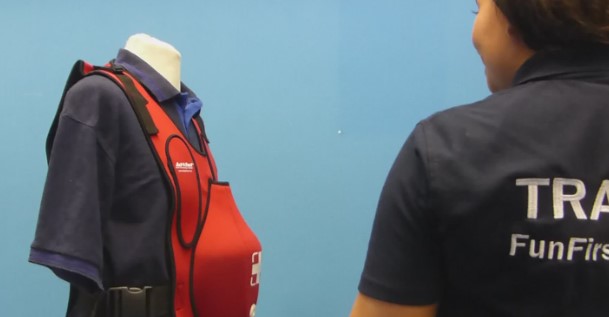
@ShahidNShah


The main purpose of first aid and CPR (Cardiopulmonary Resuscitation) training is to teach individuals how to offer immediate medical assistance in emergencies. During the training, certain pieces of equipment are typically used to simulate and practice emergency response scenarios. These tools provide a hands-on learning experience that allows participants to:
In this guide, you’ll get to explore the essential equipment needed to conduct first aid and CPR training effectively.

Chocking vests are valuable pieces of equipment for teaching the individual how to respond effectively to choking emergencies. They play an important role in simulating real-life scenarios and preparing individuals to act quickly and confidently during choking incidents.
While different types of choking vests are available, they all play the same function – provide a lifetime simulation of a choking victim, allowing students to practice the Heimlich maneuver (abdominal thrusts) in a realistic setting. This hands-on experience helps trainees understand the correct technique and force required to dislodge an obstructed airway.
With these vests, trainees can practice the Heimlich maneuver without causing harm or discomfort to an actual person. This creates a safe environment for learning and builds confidence in performing the procedure correctly during a real emergency.
Some choking training vests are equipped with indicators or sensors that provide feedback on the effectiveness of the maneuver performed. Trainees can receive immediate feedback on the force and location of their thrusts, allowing them to make necessary adjustments and improve their technique.
Chocking vests are versatile and can be adjusted to simulate different choking scenarios, such as adult or child victims and various levels of airway obstruction. This versatility helps trainees develop skills that can be applied to different age groups and situations.
When shopping for choking vests, make sure you choose one that provides a realistic simulation of a choking victim’s airway obstruction. The vest should accurately mimic the resistance and displacement of an obstructed object, such as a piece of food or a foreign object. Also, make sure it is made from durable materials that can withstand frequent use and handling, are easy to use and come with clear instructions for assembly, use and cleaning. Easy maintenance ensures the trainer remains hygienic and functional throughout its lifespan.
CPR manikins provide a realistic and interactive platform for trainees to practice life-saving CPR techniques. By simulating the physical features and responses of a human body, CPR manikins allow learners to practice chest compressions and rescue breathing with proper hand placement, depth and technique, closely resembling what would be performed during an actual emergency.
Some CPR manikins are equipped with feedback mechanisms, such as lights, sounds, or digital displays, that indicate the quality and effectiveness of CPR techniques being performed. This instant feedback helps trainees adjust their approach to achieve optimal compression depth and rate, improving overall performance.
CPR manikins are also available in different models to accommodate various training scenarios, including adult, child, and infant manikins. This diversity allows trainees to practice CPR techniques tailored to different age groups, preparing them to respond appropriately in diverse emergencies.

The AED (Automated External Defibrillator) trainer helps prepare individuals to respond effectively to sudden cardiac arrest emergencies. By closely resembling actual AED devices, these trainers teach trainees the steps involved in turning on the device, applying electrode pads, and delivering a shock.
Trainees learn to recognise the signs of cardiac arrest, follow prompts provided by the AED trainer, and respond appropriately based on simulated cardiac rhythms. This simulation-based training enhances preparedness and decision-making skills when faced with a real-life cardiac emergency.
Another great benefit of training with AED trainers is that they ensure safety for both trainees and instructions. Unlike real AEDs, trainers deliver simulated shocks without electrical discharge, minimising the risk of injury during practice sessions. Trainees can practice AED application without concern about unintentional shock delivery or harm to a patient.
Keep in mind that some CPR manikins are compatible with AED trainers. This allows trainees to practice attaching and operating an AED during simulated cardiac arrest scenarios. This integration reinforces the importance of early defibrillation in cardiac emergencies.

Tourniquets and hemostatic dressings are critical components of first aid training, especially for managing bleeding and traumatic injuries. While they are not directly related to CPR training, understanding their importance in the broader context of first aid education is essential for comprehensive emergency response preparedness.
Tourniquets are used to control life-threatening bleeding from extremities such as the arms or legs when direct pressure or other methods are insufficient. They’re applied above the wound site to compress blood vessels and halt excessive bleeding, preventing severe blood loss and potential shock.
Training in tourniquet application prepares individuals to act quickly in emergencies involving major arterial bleeding. Proper technique and placement are crucial to effectively stop bleeding and stabilise the injured person’s condition while waiting for professional medical assistance.
Hemostatic dressings contain agents that promote blood clotting and accelerate the body’s natural clotting process. They are effective in managing severe bleeding from penetrating injuries, such as gunshot wounds or deep cuts.
Because hemostatic dressings are compact and convenient to carry, this makes them suitable for use in emergencies where traditional bandages may be insufficient. Training in hemostatic dressing applications ensures that responders can quickly address critical bleeding and improve outcomes for the injured.
This trainer plays an important role in educating individuals about the administration of epinephrine (commonly known as adrenaline) during severe allergic reactions, such as anaphylaxis. This device replicates the appearance and function of a real EpiPen but doesn’t contain a needle or medication.
By handling and practising with the trainer, individuals learn how to properly hold, activate and administer epinephrine using the correct technique. Learning in a safe and controlled environment prevents the risk of accidental needle sticks or exposure to medication, ensuring safety during training sessions.

There is an urgent need for healthcare leaders to prioritize equity in women's health due to years of neglect in research and innovation. There is an urgent need to rectify historical neglect of …
Posted May 28, 2024 FemTech Equity of Access
Connecting innovation decision makers to authoritative information, institutions, people and insights.
Medigy accurately delivers healthcare and technology information, news and insight from around the world.
Medigy surfaces the world's best crowdsourced health tech offerings with social interactions and peer reviews.
© 2025 Netspective Foundation, Inc. All Rights Reserved.
Built on Apr 29, 2025 at 4:00am